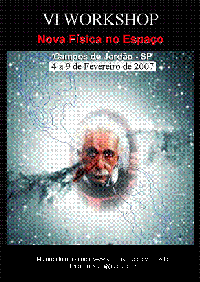 |
| Introdução |
| Objetivo |
| Programa |
| Comissão Organizadora |
| Inscrições |
| Participantes |
| Informações |
| II Workshop |
| III Workshop |
| IV Workshop |
| V Workshop |
INTRODUCTION TO THE SIXTH BRAZILIAN WORKSHOP ON NEW PHYSICS FROM SPACE
Reuven Opher
IAG/USP
MAJOR CHALLENGES IN NEW PHYSICS FROM SPACE
The program of this workshop covers the main topics in new physics from space. During this sixth workshop, the speakers will discuss recent work in their area, in addition to presenting some of their own work. Appreciable time has been set aside for discussion of the talks, which in the past workshops, has been very animated. In this introductory talk, I will discuss briefly what I consider to be some of the major challenges, both theoretical and observational, in new physics from space.
I BLACK HOLES (BHs)
- How were the BHs at the center of galaxies formed?
- Did primordial BHs form?
- Can we observe the primordial BHs?
- Can we observe BHs at the center of galaxies with a resolution ~ Schwartzschild radius?
- Can we observe the spin of a BH?
- Can we extract energy from a rotating BH?
- Does BH evaporation cease when the mass of an evaporating BH approaches the Planck mass?
- Can we observe the BHs and gravitons, predicted by extra dimension theories?
II EVOLUTION OF GALAXIES
- What is the explanation for the close correlation between:
- the central BH mass;
- the bulge mass;
- the central virial velocity; and
- the bulge luminosity?
- What is the explanation for the observed intensive stellar formation near central BHs?
- Mergers imply the creation of galaxies that have two BHs at an average separation rA ~ pc at their centers. Can we observe the predicted ejection of stars in the region r < rA?
III THE PRIMORDIAL UNIVERSE AND DARK ENERGY (DE)
- Are the primordial and present accelerations of the Universe both due to the vacuum energy produced by one-loop quantum fluctuations?
- Is the primordial and present acceleration of the Universe due to the Casimir vacuum energy of a compactified extra dimension?
IV DARK MATTER (DM)
- What is the distribution of sub-halos of DM in the halo of our galaxy?
- What is the large scale distribution of DM?
- The galaxy distribution fluctuation spectrum should follow the DM fluctuation spectrum. What is the ratio of the two specta?
- Do we now have definite evidence that DM is not simply baryon matter with a modified law of gravity?
V ASTROPARTICLES ? UHECR
- Are UHECR (ultra-high energy particles) accelerated by blobs (?cannon balls?) produced in the jets from AGNs (active galactic nuclei)?
- Are UHE photons (E ~ 1020eV ) damped by strong galactic and extragalactic magnetic fields ?
- Are UHECR produced by rapidly rotating neutron stars and/or BHs?
VI GRAVITATIONAL WAVES (GWs)
- How close are we to detecting directly GWs?
- Can we use GWs to study fundamental physics, such as:
- QCD (quantum chromodynamics) in the cores of neutron stars; and
- DE with GW standard candles?
- Will we detect shortly GWs from coalescing MACHOs (massive compact halo objects)?
- Can we increase the sensitivity of GW detectors from GRBs (gamma ray bursts), using the coincidence of the GWs with the emitted gamma rays?
VII COSMIC MICROWAVE BACKGROUND (CMB)
- Can we determine accurately the primordial GWs in the CMB (B-Mode) and, therefore, the ratio of GW tensor modes to density fluctuation scalar modes?
- Can we detect primordial magnetic fields (~ nG) with the CMB?
VIII PLASMA ASTROPHYSICS
- Are the magnetic fields in the IGM intense ?
- How are highly collimated jets from AGNs formed?
- Is the origin of the reionization of the Universe at z~10 due to
- radiation from first stars; or
- primordial magnetic fields?
- Can we determine the intergalactic magnetic field from the UHECR scattering data?
IX THE TOPOLOGY OF THE UNIVERSE
- Is there a connection between:
- the north-south asymmetry of the CMB;
- alignmente of the low multipoles of the CMB; and
- the topology of the Universe?